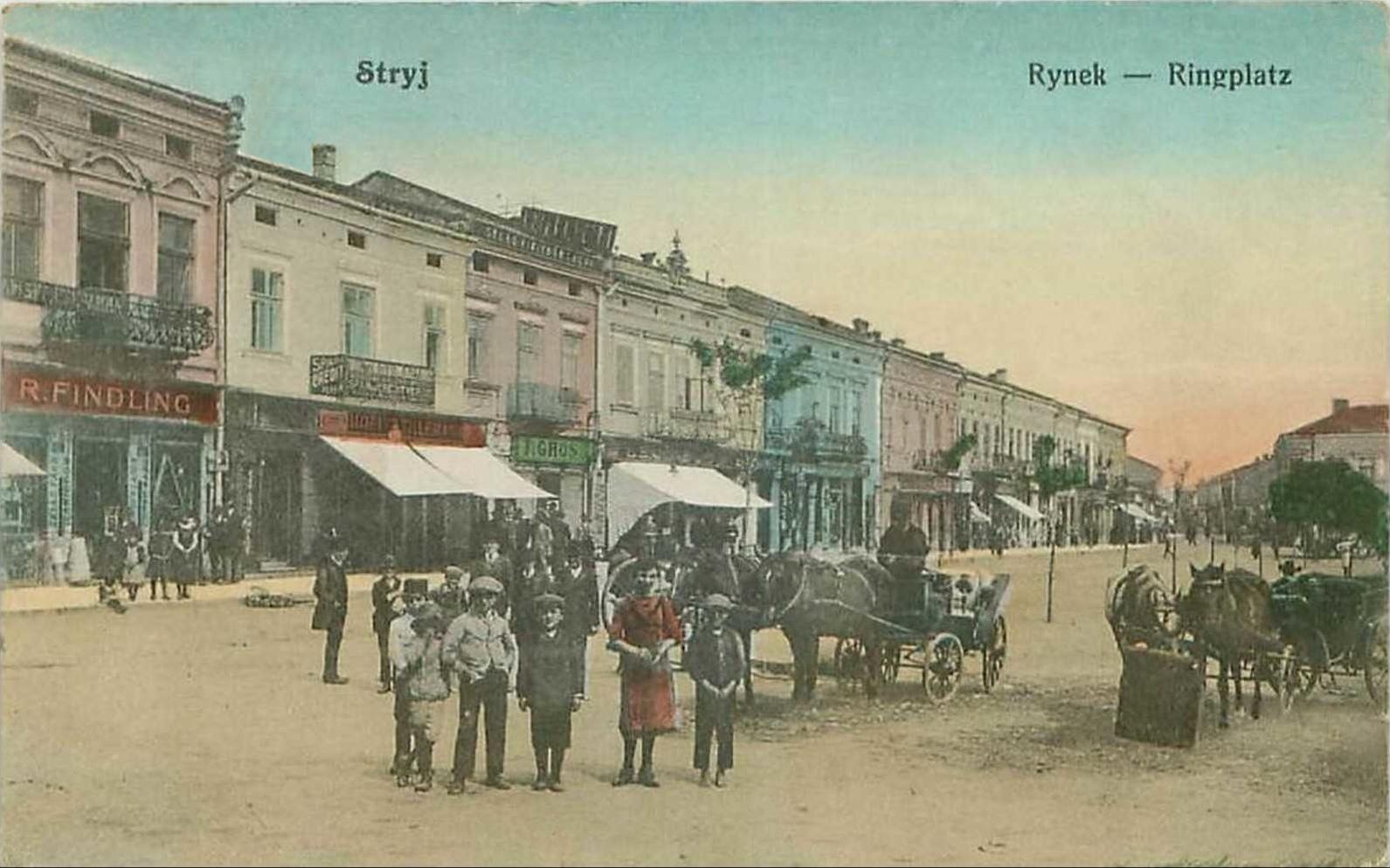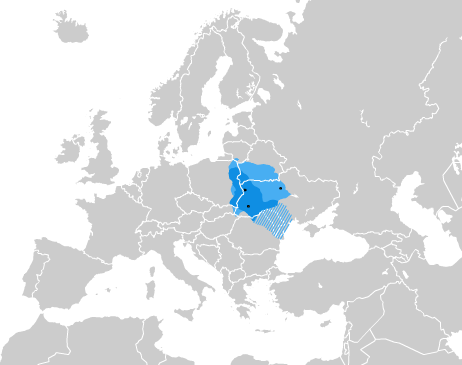|
Duliby, Stryi Raion
Duliby ( uk, Дулі́би) is a village (''selo'') located along the Stryi River in Stryi Raion (district) of Lviv Oblast (province) in Western Ukraine. It hosts the administration of Hrabovets-Duliby rural hromada, one of the hromadas of Ukraine. The population of the village is about 3 671 people. Local government is administered by Dulibivska village council. Geography The village is located in the direction of the Highway M06 (Ukraine) () at a distance from Stryi, from the regional center of Lviv and from Uzhhorod. History The first mention recorded in the court documents dated 1463. Cult constructions and religion Church of St. George 1923 (Wooden) and church of the Transfiguration (stone) is in the village. Gallery File:Church of St. George 1923 (wooden), Duliby.JPG, Church of St. George 1923 (wooden). File:The bell tower of the church of St. George.JPG, The bell tower of the church of St. George. File:St.George church 1920-1923, Duliby.JPG, St.Georg ... [...More Info...] [...Related Items...] OR: [Wikipedia] [Google] [Baidu] |
Village
A village is a clustered human settlement or community, larger than a hamlet but smaller than a town (although the word is often used to describe both hamlets and smaller towns), with a population typically ranging from a few hundred to a few thousand. Though villages are often located in rural areas, the term urban village is also applied to certain urban neighborhoods. Villages are normally permanent, with fixed dwellings; however, transient villages can occur. Further, the dwellings of a village are fairly close to one another, not scattered broadly over the landscape, as a dispersed settlement. In the past, villages were a usual form of community for societies that practice subsistence agriculture, and also for some non-agricultural societies. In Great Britain, a hamlet earned the right to be called a village when it built a church. [...More Info...] [...Related Items...] OR: [Wikipedia] [Google] [Baidu] |
Lev Shankovsky
Lev Shankovsky ( uk, Шанко́вський Лев Петро́вич, ), (pseudonym - ''"Dzvin"'', ''"Oleh Martovych"'') was a Ukrainian military historian and former Ukrainian Insurgent Army (UPA) soldier, a leading member of the Organization of Ukrainian Nationalists. He was a full member of the Shevchenko Scientific Society. Shankovsky was born in 1903 in the village of Duliby, Stryi Raion. He received military education in Ukrainian and Polish schools and served in the armies of the UPR and the UGA. Participants of the First Winter Campaign (1920). During the Second World War he participated in the Resistance in the Ukrainian Insurgent Army. In January 1944, Shankovsky, as a leader of the UPA forces, headed the initiating commission that established contacts with representatives of former Ukrainian political parties as well as nonpartisan activists. Shankovsky, for example, asserted at a round-table discussion that organized anti-Semitism "never existed" in Ukraine. ... [...More Info...] [...Related Items...] OR: [Wikipedia] [Google] [Baidu] |
Ukrainian Greek Catholic Church
, native_name_lang = uk , caption_background = , image = StGeorgeCathedral Lviv.JPG , imagewidth = , type = Particular church (sui iuris) , alt = , caption = St. George's Cathedral in Lviv, mother church of Ukrainian Greek Catholic Church , abbreviation = UGCC , main_classification = Eastern Catholic , orientation = Eastern Christianity , theology = Catholic Theology , governance=Synod of the Ukrainian Catholic Church , polity = Episcopal , leader_title = Pope , leader_name = Francis , leader_title2 = Major Archbishop , leader_name2 = Sviatoslav Shevchuk , division_type = Parishes , division = 3993 , director = , fellowships = , associations = , area = Mainly: Ukraine Minority: Canada, the United States, Australia, France, the United Kingdom, Germany, Brazil, Poland, Lithuania and ... [...More Info...] [...Related Items...] OR: [Wikipedia] [Google] [Baidu] |
Ostap Nyzhankivsky
Ostap Yosypovych Nyzhankivsky ( uk, Остап Йосипович Нижанківський and ); January 24, 1863 – May 22, 1919) – Ukrainian writer and cleric, a priest of the Ukrainian Greek Catholic Church, composer, conductor, and public figure. Life Ostap Nyzhankivsky born in the village of Mali Didushychi (today Stryi district of Lviv region) January 24, 1863. He was born in a large family of Greek Catholic priest of Joseph Nyzhankivsky (1836 - 1911), which was a priest of the Greek Catholic parish in the village Mali Didushychi. Then the family moved to the village Zavadiv. He studied in the nearby village Duliby and later he studied in Drohobych and Lviv gymnasium. Ostap Nyzhankivsky was expelled from the sixth grade of gymnasium and had to enter military service in the Austrian army in Lviv (1882-1885). Ostap has participated in the company “Academic Fraternity”, where he met Ivan Franko and with the composer, conductor and public figure Anatole ... [...More Info...] [...Related Items...] OR: [Wikipedia] [Google] [Baidu] |
Uzhhorod
Uzhhorod ( uk, У́жгород, , ; ) is a city and municipality on the river Uzh in western Ukraine, at the border with Slovakia and near the border with Hungary. The city is approximately equidistant from the Baltic, the Adriatic and the Black Sea (650–690 km) making it the most inland city in this part of Europe. It is the administrative center of Zakarpattia Oblast (region), as well as the administrative center of the Uzhhorod Raion (district) within the oblast. Population: Name The city's earliest known name is ''Ungvár'', from Hungarian ''Ung'' ( River Uzh) and ''vár'' "castle, fortress", originally referring to a castle outside the city (probably Nevytske Castle). The name ''Uzhhorod'' was coined in early 19th century Slavophile circles as a literal translation of the name ''Ungvár''. The city officially adopted this name some time after 1920, under Czechoslovak administration. The names of the city also include: en, link=no, Uzhgorod (before 1996); rue, ... [...More Info...] [...Related Items...] OR: [Wikipedia] [Google] [Baidu] |
Lviv
Lviv ( uk, Львів) is the largest city in western Ukraine, and the seventh-largest in Ukraine, with a population of . It serves as the administrative centre of Lviv Oblast and Lviv Raion, and is one of the main cultural centres of Ukraine. It was named in honour of Leo, the eldest son of Daniel, King of Ruthenia. Lviv emerged as the centre of the historical regions of Red Ruthenia and Galicia in the 14th century, superseding Halych, Chełm, Belz and Przemyśl. It was the capital of the Kingdom of Galicia–Volhynia from 1272 to 1349, when it was conquered by King Casimir III the Great of Poland. From 1434, it was the regional capital of the Ruthenian Voivodeship in the Kingdom of Poland. In 1772, after the First Partition of Poland, the city became the capital of the Habsburg Kingdom of Galicia and Lodomeria. In 1918, for a short time, it was the capital of the West Ukrainian People's Republic. Between the wars, the city was the centre of the Lwów Voivodeship in th ... [...More Info...] [...Related Items...] OR: [Wikipedia] [Google] [Baidu] |
Stryi
Stryi ( uk, Стрий, ; pl, Stryj) is a city located on the left bank of the river Stryi in Lviv Oblast (region) of western Ukraine 65 km to the south of Lviv (in the foothills of the Carpathian Mountains). It serves as the administrative center of Stryi Raion (district). Stryi hosts the administration of Stryi urban hromada, one of the hromadas of Ukraine. Its population is approximately . Stryi is considered to be the first city in Ukraine to bear the blue-over-yellow Ukrainian national flag when it was hoisted on the flagpole of the Town Hall on March 14, 1990, even before the fall of the Soviet Union in December 1991. Population Name The city takes its name from the name of the river Stryi, one of the tributaries of the Dniester. Stryi, as a name of river is a very old name and means "stream". Its etymology stems from an Indo-European root *sreu. Words that have the same root can be found in modern Ukrainian - струм, струя, Polish - ''struga'', ''strumie� ... [...More Info...] [...Related Items...] OR: [Wikipedia] [Google] [Baidu] |
Highway M06 (Ukraine)
Highway M06 is a Ukrainian international highway ( M-highway) connecting Kyiv to the Hungarian border near Chop, where it continues as Hungarian main road 4 to Záhony and Budapest. General overview The M06 is a major transnational corridor and along with the M03 combines into European route E40. The highway is also part of the Pan-European Transportation corridors III and V as well as the "Europe-Asia" Transportation corridor. It is the second longest route spanning over . For most of its length it is categorized as the category Ia highway in Ukraine (see Roads in Ukraine). The M06 connects four major European routes: E40, E50, E85, and E95. History The route from Lemberg via Stryj to the then Austro-Hungarian border belonged until 1918 to the Austrian crown land of Galicia and was called the ''Stryjer Reichsstraße''. Description From Kyiv to Lviv the M06 is part of European route E40, European route E471 from Lviv to Mukachevo, European route E50 from Stryi ( Lviv ... [...More Info...] [...Related Items...] OR: [Wikipedia] [Google] [Baidu] |
Hromada
A hromada ( uk, територіальна громада, lit=territorial community, translit=terytorialna hromada) is a basic unit of administrative division in Ukraine, similar to a municipality. It was established by the Government of Ukraine on 12 June 2020. Similar terms exist in Poland (''gromada'') and in Belarus (''hramada''). The literal translation of this term is "community", similarly to the terms used in western European states, such as Germany ('' Gemeinde''), France (''commune'') and Italy (''comune''). History In history of Ukraine and Belarus, hromadas appeared first as village communities, which gathered their meetings for discussing and resolving current issues. In the 19th century, there were a number of political organizations of the same name, particularly in Belarus. Prior to 2020, the basic units of administrative division in Ukraine were rural councils, settlement councils and city councils, which were often referred to by the generic term ''hromada ... [...More Info...] [...Related Items...] OR: [Wikipedia] [Google] [Baidu] |
Western Ukraine
Western Ukraine or West Ukraine ( uk, Західна Україна, Zakhidna Ukraina or , ) is the territory of Ukraine linked to the former Kingdom of Galicia–Volhynia, which was part of the Polish–Lithuanian Commonwealth, the Austrian Empire, Austria-Hungary and the Second Polish Republic, and came fully under the control of the Soviet Union (via the Ukrainian Soviet Socialist Republic) only in 1939, following the Molotov–Ribbentrop Pact. There is no universally accepted definition of the territory's boundaries (see the map, right), but the contemporary Ukrainian administrative regions or Oblasts of Chernivtsi, Ivano-Frankovsk, Lviv, Ternopil and Transcarpathia (which were part of the former Austro-Hungarian Empire) are nearly always included and the Lutsk and Rivne Oblasts (parts of the annexed from Poland during its Third Partition) are usually included. It is less common to include the Khmelnytski and, especially, the Vinnytsia and Zhytomyr Oblasts in this c ... [...More Info...] [...Related Items...] OR: [Wikipedia] [Google] [Baidu] |
Oblasts Of Ukraine
An oblast ( uk, о́бласть; ) in Ukraine, often called a region or province, is the main type of first-level administrative division of the country. Ukraine's territory is divided into 24 oblasts, as well as one autonomous republic, Crimea, and two cities with special status, Kyiv and Sevastopol. Ukraine is a unitary state, thus the oblasts do not have much legal scope of competence other than that which is established in the Ukrainian Constitution and by law. Articles 140–146 of Chapter XI of the constitution deal directly with local authorities and their competency. Oblasts are subdivided into raions (districts), each oblast having from 3 to 10 raions following the July 2020 reform. General characteristics In Ukraine, the term ''oblast'' denotes a primary administrative division. Under the Russian Empire and into the 1920s, Ukraine was divided between several governorates. The term ''oblast'' was introduced in 1932 by Soviet authorities when the Ukrainian SSR was ... [...More Info...] [...Related Items...] OR: [Wikipedia] [Google] [Baidu] |






